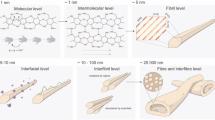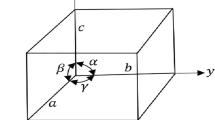Abstract
Celery collenchyma cell walls are typical of primary plant cell walls in their composition but contain unusually well-oriented cellulose microfibrils that are packed with more regularity than normal, permitting small-angle X-ray scattering (SAXS) experiments that would not otherwise be possible. Small-angle scattering data were obtained for the cell walls in essentially their native state and for isolated cellulose, in a fibrous form that retained the physical shape and microfibril orientation of the native cell walls. The scattering patterns showed a distinct peak attributed to the interference contribution to the convolution of form and interference functions. The position of the peak attributed to the interference function implied a mean centre-to-centre microfibril spacing of approximately 3.2 nm in dry isolated cellulose and 3.8 nm in dry cell walls. Hydration increased the mean microfibril spacing in the cell walls to 5.4 nm but had only a small effect on the mean microfibril spacing of isolated cellulose. In the scattering profile from intact, hydrated cell walls it was just possible to discern the position of the first Bessel minimum, from which a microfibril diameter in the range 3.1–3.6 nm may be estimated. This estimate is likely to include attached hemicellulose chains. Porod plots of scattering intensity indicated a relatively sharp interface between microfibrils and their immediate surroundings. The SAXS data imply that cellulose microfibrils 2.6–3.0 nm in diameter are not quite in lateral contact with one another in the isolated cellulose and are augmented by hemicelluloses and separated by readily hydrated matrix polysaccharides in the native plant cell wall.






Similar content being viewed by others
References
Abramovitz M, Steugen I (1970) Handbook of mathematical functions. National Bureau of Standards, Washington D.C
Astley OM, Donald AM (2001) A small-angle X-ray scattering study of the effect of hydration on the microstructure of flax fibers. Biomacromolecules 2:672–680
Beaucage G (1995) Approximations leading to a unified exponential power-law approach to small-angle scattering. J Appl Crystallogr 28:717–728
Beer M, Setterfield G (1958) Fine structure in thickened primary walls of collenchyma cells of celery petioles. Am J Bot 45:571–580
Crawshaw J, Bras W, Mant GR, Cameron RE (2002) Simultaneous SAXS and WAXS investigations of changes in native cellulose fiber microstructure on swelling in aqueous sodium hydroxide. J Appl Polym Sci 83:1209–1218
Fenwick KM, Jarvis MC, Apperley DC (1997) Estimation of polymer rigidity in cell walls of growing and nongrowing celery collenchyma by solid-state nuclear magnetic resonance in vivo. Plant Physiol 115:587–592
Fratzl P, Burgert I, Keckes J (2004) Mechanical model for the deformation of the wood cell wall. Zeits Metall 95:579–584
Garvey CJ, Parker IH, Knott RB, Simon GP (2004) Small angle scattering in the Porod region from hydrated paper sheets at varying humidities. Holzforschung 58:473–479
Green PB (1999) Expression of pattern in plants: combining molecular and calculus-based biophysical paradigms. Am J Bot 86:1059–1076
Jakob HF, Fratzl P, Tschegg SE (1994) Size and arrangement of elementary cellulose fibrils in wood cells – a small-angle X-ray-scattering study of Picea abies. J Struct Biol 113:13–22
Jakob HF, Fengel D, Tschegg SE, Fratzl P (1995) The elementary cellulose fibril in Picea abies: comparison of transmission electron microscopy, small-angle X-ray scattering, and wide-angle X-ray scattering results. Macromolecules 28:8782–8787
Jakob HF, Tschegg SE, Fratzl P (1996) Hydration dependence of the wood-cell wall structure in Picea abies. A small-angle X-ray scattering study. Macromolecules 29:8435–8440
Jarvis MC (1992) Control of thickness of collenchyma cell-walls by pectins. Planta 187:218–220
Kennedy CJ, Cameron GJ, Sturcova A, Apperley DA, Altaner C, Wess TJ, Jarvis MC (2007) Microfibril diameter in celery collenchyma cellulose: X-ray scattering and NMR evidence. Cellulose (in press)
Kerstens S, Verbelen JP (2003) Cellulose orientation at the surface of the Arabidopsis seedling. Implications for the biomechanics in plant development. J Struct Biol 144:262–270
Lenz J, Schurz J, Wrentschur E (1993) Properties and structure of solvent-spun and viscose-type fibers in the swollen state. Colloid Polym Sci 271:460–468
Lockhart JA (1965) An analysis of irreversible plant cell elongation. J Theor Biol 8:264
Marga F, Grandbois M, Cosgrove DJ, Baskin TI (2005) Cell wall extension results in the coordinate separation of parallel microfibrils: evidence from scanning electron microscopy and atomic force microscopy. Plant J 43:181–190
McCann MC, Wells B, Roberts K (1990) Direct visualization of cross-links in the primary plant-cell wall. J Cell Sc 96:323–334
McCann MC, Stacey NJ, Wilson R, Roberts K (1993) Orientation of macromolecules in the walls of elongating carrot cells. J Cell Sci 106:1347–1356
McQueen-Mason S, Cosgrove DJ (1994) Disruption of hydrogen-bonding between plant-cell wall polymers by proteins that induce wall extension. Proc Natl Acad Sci USA 91:6574–6578
Müller M, Czihak C, Vogl G, Fratzl P, Schober H, Riekel C (1998) Direct observation of microfibril arrangement in a single native cellulose fiber by microbeam small-angle X-ray scattering. Macromolecules 31:3953–3957
Passioura JB, Fry SC (1992) Turgor and cell expansion – beyond the Lockhart Equation. Aust J Plant Physiol 19:565–576
Pilet PE, Roland JC (1974) Growth and extensibility of collenchyma cells. Plant Sci Lett 2:203–207
Porod G (1951) Die Röntgenkleinwinkelstreuung von dichtgepackten kolloiden Systemen .1. Kolloid-Zeits Zeits Polym 124:83–114
Sturcova A, His I, Apperley DC, Sugiyama J, Jarvis MC (2004) Structural details of crystalline cellulose from higher plants. Biomacromolecules 5:1333–1339
Urban V, Narayanan T, Grubel G, Riekel C (2001) Small-angle scattering beamlines at the European Synchrotron Radiation Facility. Abstr Papers Am Chem Soc 222:U356–U356
Wess TJ, Drakopoulos M, Snigirev A, Wouters J, Paris O, Fratzl P, Collins M, Hiller J, Nielsen K (2001) The use of small angle X-ray diffraction studies for the analysis of structural features in archaeological samples. Archaeometry 43:117–129
Acknowledgements
This work was conducted as part of a long-term proposal at the ESRF. We thank BBSRC (grant no. BBS/B/09643) for financial support. We also thank Tomas Weiss, beamline scientist at station ID02, ESRF, for technical assistance.
Author information
Authors and Affiliations
Corresponding author
Rights and permissions
About this article
Cite this article
Kennedy, C.J., Šturcová, A., Jarvis, M.C. et al. Hydration effects on spacing of primary-wall cellulose microfibrils: a small angle X-ray scattering study. Cellulose 14, 401–408 (2007). https://doi.org/10.1007/s10570-007-9129-9
Received:
Accepted:
Published:
Issue Date:
DOI: https://doi.org/10.1007/s10570-007-9129-9




